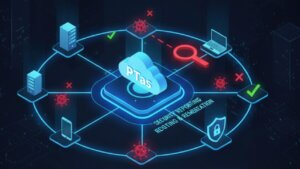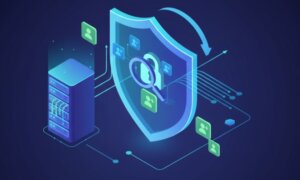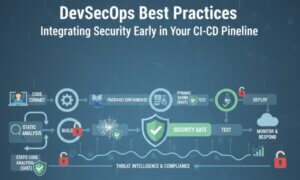The evolution of cloud computing has revolutionized how businesses store, manage, and protect their data. However, with great innovation comes great responsibility, particularly in the realm of security. Ensuring data protection in cloud environments is vital for maintaining trust, compliance, and business continuity. This blog delves into the intricacies of cloud computing security and cloud data management, offering actionable insights for safeguarding your digital assets.
Table of Contents
Understanding Data Protection in Cloud Computing
Data protection in cloud computing refers to the strategies, practices, and technologies used to secure sensitive information stored in cloud environments. It involves ensuring the confidentiality, integrity, and availability of data against threats like breaches, unauthorized access, and accidental loss. With businesses increasingly relying on the cloud, robust data protection mechanisms are no longer optional.
The Importance of Cloud Computing Security
Alleviate Data Breaches: Cloud environments, though robust, are not immune to breaches. Strong security measures can prevent unauthorized access to sensitive information.
Compliance with Regulations: Regulations like GDPR, HIPAA, and CCPA mandate strict data protection practices. Non-compliance can lead to hefty fines and reputational damage.
Business Continuity: Secure data ensures that businesses can recover quickly from incidents like ransomware attacks or natural disasters.
Customer Trust: Protecting data reinforces trust among customers, partners, and stakeholders.
Key Challenges in Cloud Data Management
Data Visibility and Control: Managing data across multiple cloud platforms can make it challenging to maintain visibility and control.
Shared Responsibility Model: Cloud providers manage the infrastructure’s security, but customers are responsible for securing their data, applications, and configurations.
Data Governance: Ensuring proper classification, storage, and access policies for data requires a comprehensive approach to governance.
Insider Threats: Employees or partners with access to cloud data can inadvertently or intentionally cause data breaches.
Best Practices for Cloud Computing Security
1. Data Encryption
Encryption is a cornerstone of cloud security. It ensures that data remains unreadable to unauthorized entities both in transit and at rest. Use strong encryption protocols like AES-256 and ensure that encryption keys are securely managed.
2. Identity and Access Management (IAM)
Implementing robust IAM policies minimizes the risk of unauthorized access. Best practices include:
Enforcing least privilege access.
Using multi-factor authentication (MFA).
Regularly reviewing and updating access controls.
3. Regular Audits and Monitoring
Conduct regular audits of your cloud environment to identify vulnerabilities and misconfigurations. Use monitoring tools to track unusual activity and respond to threats in real time.
4. Data Backup and Recovery
A comprehensive backup strategy is essential for protecting against data loss. Use automated backup solutions and regularly test recovery processes to ensure they meet your business needs.
5. Compliance Management
Understand the regulatory requirements applicable to your industry and implement policies to ensure compliance. Leverage tools provided by cloud providers for compliance reporting and auditing.
Role of Cloud Providers in Data Protection
Leading cloud providers play a pivotal role in enhancing cloud computing security and cloud data management by offering robust tools and services designed to safeguard data. Let’s examine the contributions of major providers:
Amazon Web Services (AWS)
AWS is known for its comprehensive suite of security tools that enable businesses to protect their data:
AWS Key Management Service (KMS): Provides encryption key management, ensuring that data is protected both at rest and in transit.
AWS Identity and Access Management (IAM): Facilitates granular control over access to cloud resources, enabling organizations to enforce the principle of least privilege.
Amazon GuardDuty: Offers continuous threat detection and automated responses to potential security events.
AWS CloudTrail: Logs all API calls and user activity, providing detailed visibility into operations for auditing and compliance purposes.
AWS’s strong focus on scalability and customizability allows businesses to implement security measures tailored to their unique requirements.
Google Cloud Platform (GCP)
GCP emphasizes built-in security features and intelligent threat prevention:
Encryption by Default: Ensures that all data is encrypted at rest and in transit without requiring user intervention.
Cloud Identity: Centralized identity and access management that integrates seamlessly with other GCP services.
Security Command Center: Provides a unified platform for monitoring, identifying, and responding to potential security risks across the cloud environment.
VPC Service Controls: Adds a layer of defense by restricting access to sensitive resources based on specific policies.
GCP’s integration of machine learning into its security tools helps businesses proactively identify and mitigate risks.
Microsoft Azure
Azure delivers a wide range of security solutions to address diverse business needs:
Azure Security Center: A unified management solution that provides advanced threat protection across hybrid cloud environments.
Azure Active Directory (Azure AD): Centralized identity and access management for seamless integration with on-premises and cloud applications.
Azure Backup: Ensures data availability and rapid recovery in the event of a loss or breach.
Confidential Computing: Protects sensitive data during processing by isolating it in secure enclaves.
Azure’s hybrid cloud capabilities make it a preferred choice for organizations looking to integrate on-premises and cloud-based systems securely.
These cloud providers also actively invest in compliance frameworks and certifications, making it easier for businesses to meet regulatory requirements. By leveraging their advanced security features and best practices, organizations can significantly enhance their data protection strategies.
Why Businesses Trust SecureMyOrg for Comprehensive Network Security
At SecureMyOrg, we uncover and fix all possible security vulnerabilities of mobile and web, while providing solutions to mitigate risks. We are trusted by renowned companies like Yahoo, Gojek and Rippling, and with 100% client satisfaction, you’re in safe hands!







Some of the things people reach out to us for –
- Building their cybersecurity program from scratch – setting up cloud security using cost-effective tools, SIEM for alert monitoring, building policies for the company
- Vulnerability Assessment and Penetration Testing ( VAPT ) – We have certified professionals, with certifications like OSCP, CREST – CPSA & CRT, CKA and CKS
- DevSecOps consulting
- Red Teaming activity
- Regular security audits, before product release
- Full time security engineers.
Relevant Posts

AI-Powered Phishing Emails: 7 Ways to Spot and Stop Them Before They Strike
Penetration testing as a service (PTaaS) lets experts simulate real attacks to uncover vulnerabilities before hackers do. This guide explains the process, benefits, and costs, helping businesses strengthen defenses with predictable, ongoing security checks.

Why Regular Penetration Testing is Essential for Modern Companies
Penetration testing as a service (PTaaS) lets experts simulate real attacks to uncover vulnerabilities before hackers do. This guide explains the process, benefits, and costs, helping businesses strengthen defenses with predictable, ongoing security checks.

What Is Penetration Testing as a Service?
Penetration testing as a service (PTaaS) lets experts simulate real attacks to uncover vulnerabilities before hackers do. This guide explains the process, benefits, and costs, helping businesses strengthen defenses with predictable, ongoing security checks.

How To Inspect Encrypted Traffic Without Breaking Privacy
Network administrators face a challenge: securing systems while respecting privacy. This guide explains how to inspect encrypted traffic without breaking privacy using metadata, anomaly detection, and machine learning ensuring visibility, compliance, and trust.

How to Audit Infrastructure as Code (IaC) for Security Vulnerabilities
Discover how to audit Infrastructure as Code (IaC) for security vulnerabilities with this practical guide. Learn to scan IaC files using tools like Checkov, fix issues like exposed resources, and integrate audits into CI/CD pipelines. Protect your cloud systems from misconfigurations and ensure compliance with clear, actionable steps.

DevSecOps Best Practices: Integrating Security Early in Your CI/CD Pipeline
This article provides a practical guide to embedding security into every stage of your CI/CD pipeline. Learn core DevSecOps best practices like SAST, DAST, dependency scanning, secrets management, and compliance automation to catch vulnerabilities early, foster a culture of shared ownership, and build a secure-by-design development process that accelerates release cycles.
